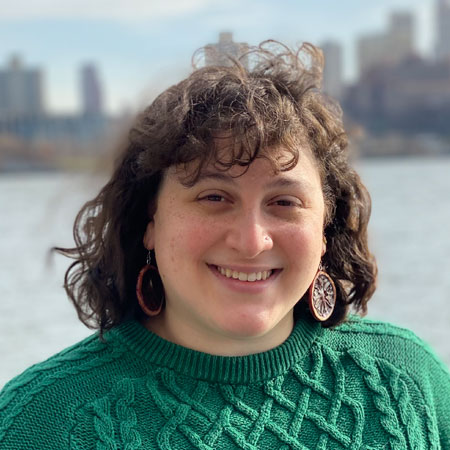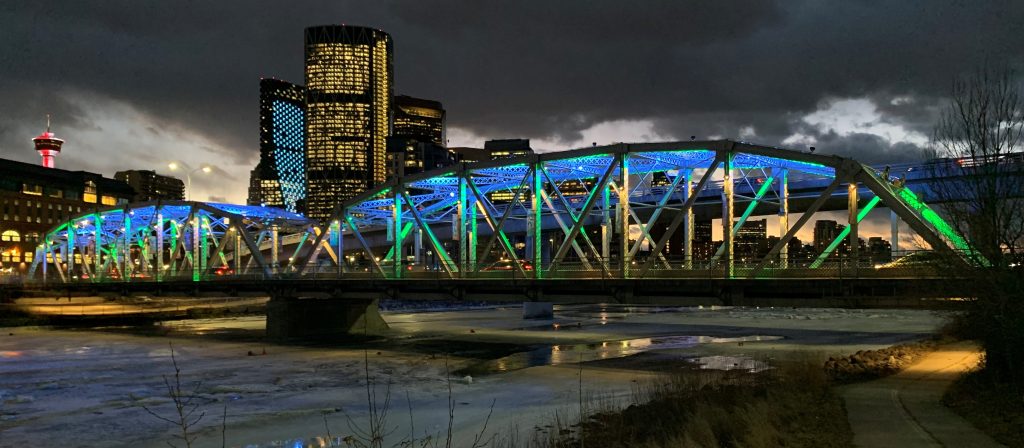A one-way bridge in Canada honors local Indigenous past
How does society go back in time and right its social injustices? Can it? How does the modern design industry fit into that reconciliation? How can lighting honor the past and serve the present? These questions came into consideration when an iron-truss bridge in downtown Calgary, Canada, originally constructed in 1910, needed an upgrade. The city’s Municipal Land Corporation (CMLC) determined a lighting program honoring and celebrating Indigenous stories, culture and history was the right approach, and brought the city’s Indigenous Relations Office, local Elders and Knowledge Keepers as well as designers from lightSPACE at SMP Engineering into the mix. Together, the council reworked a contemporary city icon, renamed Reconciliation Bridge by the city, to not only cross the Namaahka (Bow River) but also cultural divides.
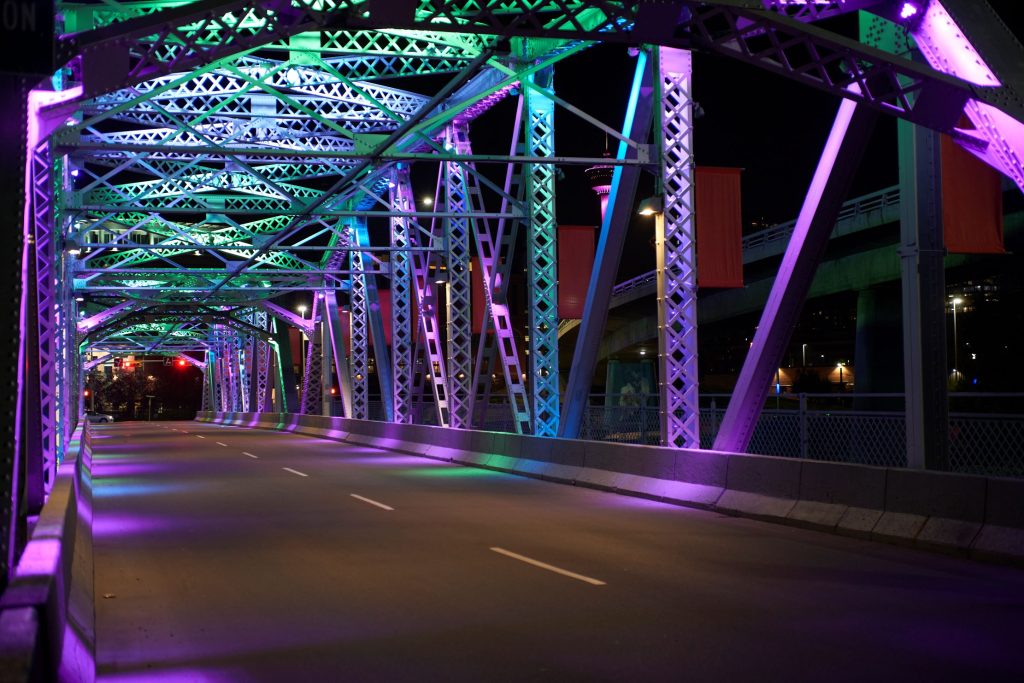
“As our design team came from [white] settler-culture backgrounds, we identified the need to receive inspiration and appropriate direction from Indigenous peoples early in our design process,” said Geoff Bouckley, studio lead at lightSPACE. “Understanding our place within the story was critical,” added Anton deGroot, former lighting designer with lightSPACE and lead designer on the project. “With this in mind, I approached the design process with the question that I always begin with: What is the story I want to tell? Understanding that for the first time in my long career as a lighting designer that this was a trick question, I wrote in my sketchbook: ‘I am not the storyteller here, merely the architect of a palette with which others may tell their stories.’” Bouckley continued, “These conversations, which occurred over several months, were key to expanding our understanding and knowledge beyond general information, which often focuses on tragic events; rather we were guided to focus on stories, joyful expressions of art and place. Eventually, this culminated in our programming, which was then reviewed by CMLC and our Indigenous advisors to ensure appropriate expression.”
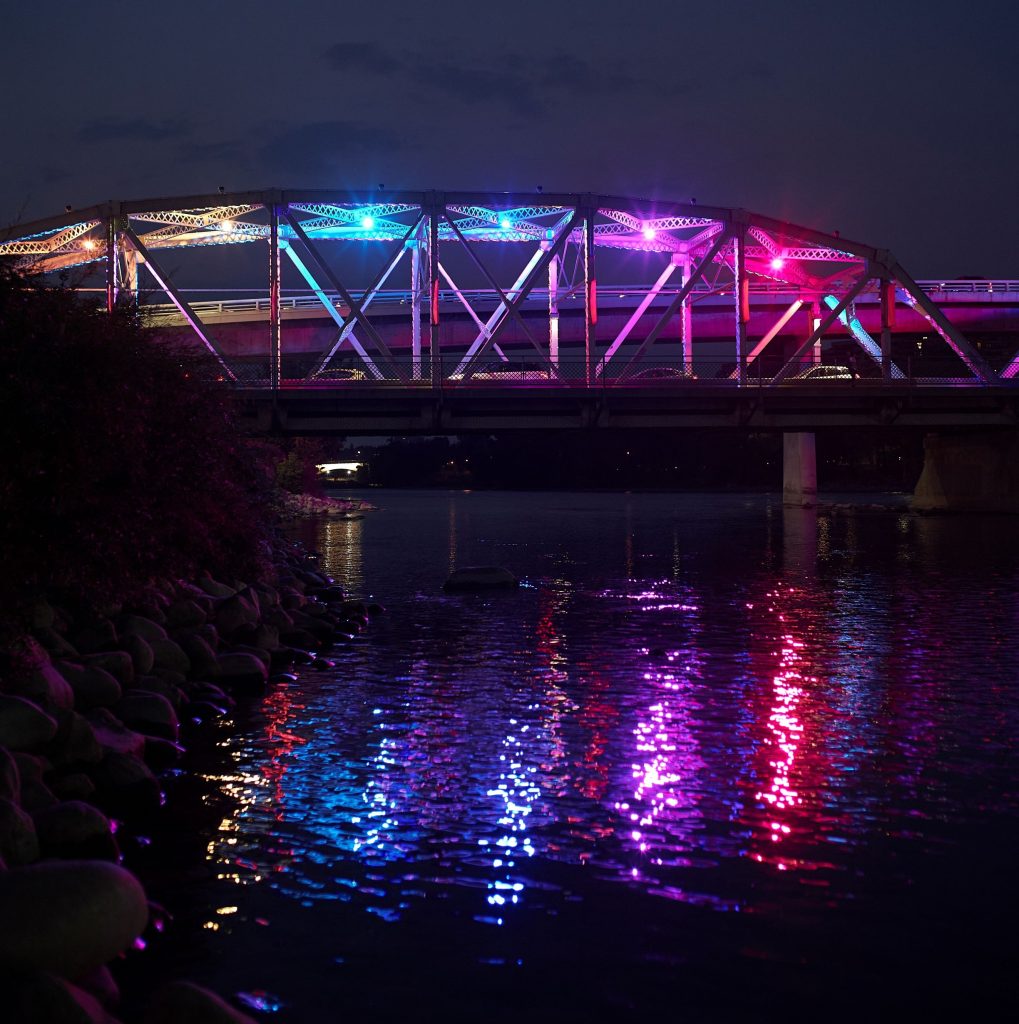
To provide safe illumination for pedestrians and vehicles, as well as to hold space for continued reconciliation and celebration, the design team planned a strategy that would reveal the bridge’s structure through silhouette and immersion, along with color-changing patterns based on cultural markers, events and seasons. “We wanted the bridge to glow above the river surface,” explained Bouckley. “The intention was to have all the color-changing light emanate from inside the bridge so that people approaching would see the structure in silhouette while color and pattern shift within. Additionally, the colored light that escapes the bridge glows onto the river and shoreline, connecting the natural space to the constructed.”
For safety, two-head Ecosense RISE Duo flood-lights with 15-deg by 60-deg optics were mounted above banners, while Lithonia WST sconces with diffused comfort optics were selected for above the roadway—both supply static 3000K CCT illumination. Selux M125 Exterior Linears set to the same color temperature and placed above pathways that pass beneath the bridge provide additional pedestrian care.
To further execute the glowing lantern-like effect, the team needed fixtures with flexibility. A combination of 25-W FL25 and 100-W FL100 RGBW fixtures by GVA were mounted on the bridge interior, atop the structure’s arches and within box trusses. The former fixtures were selected to provide a concentrated graze of light to beams and columns, as well as for their small size that allowed for placement within truss boxes, while the latter, larger fixtures broadly wash the truss of the bridge with light. “I teach theatrical lighting design and when I do, I invoke what we call the Controllable Qualities of Light: direction, intensity, color and time; the manipulation of these four qualities is what allows us to construct moments of drama and story both on-stage and off,” said deGroot. “The GVA luminaires we found allowed us to check off each one of these qualities: the optics options and IP rating allowed us to control directionality; the lumen output gave us the intensity that was required to fully illuminate the trusswork; the RBGW allowed for excellent color mixing for maximum effect; and the DMX control systems allowed us a granularity in how we change the stories over time.”
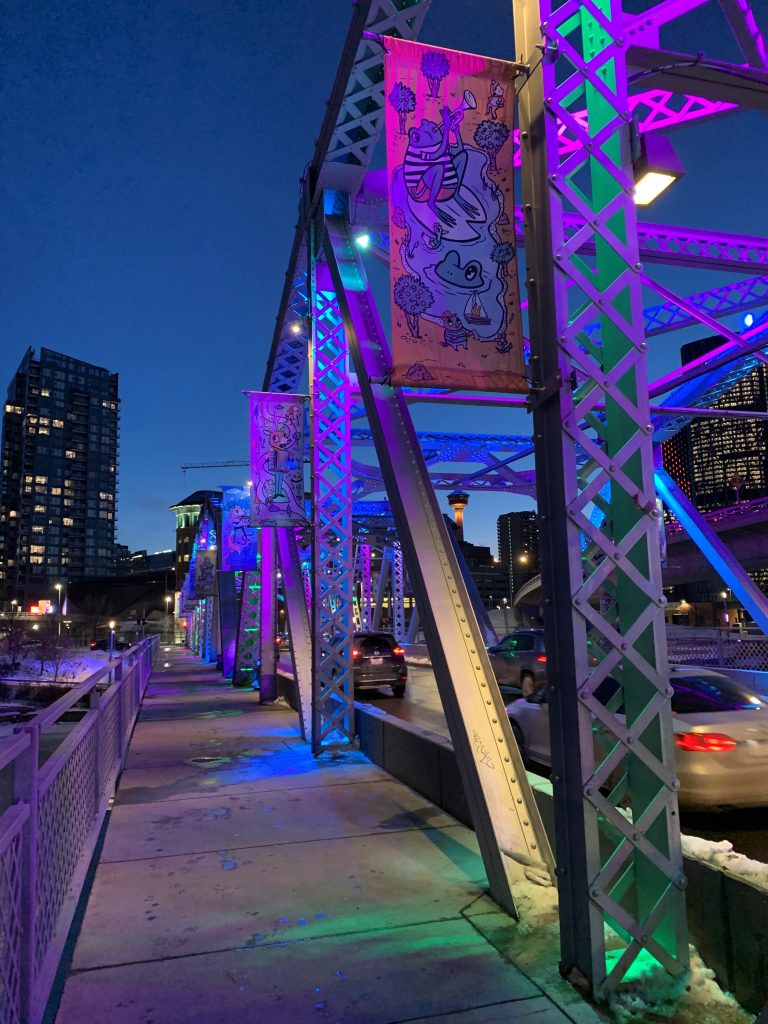
As the bridge allows community members to traverse from the north side of the river to the south side, the team paid close attention to the comfort of drivers and the direction of oncoming traffic in late-night and early morning commutes. “We made the choice to tip the directional side-lights ‘down-stage’ and away from the oncoming flow of traffic by somewhere between 3 and 5 deg. This did not take away from the visual effect, but ensured that not a hint of glare would catch a commuter’s eye, leaving them to experience their transit with ease and comfort,” explained deGroot.
Core color-changing scenes, which connect the bridge to the community and its natural surroundings, can be broken down into four broad-categories: Natural Events, Cultural Expressions, Days of Honor and scenes connected to a diverse range of cultural communities. From there, categories can be broken into further subcategories. For example, Natural Events includes colors associated with the four seasons; special palettes for the Equinox and Solstices with colors associated with the Four Medicine Wheel including, yellow, red, dark blue and white; as well as Full Moon Cycles in which lights transition from warm-white to cool-white and back again throughout the night.
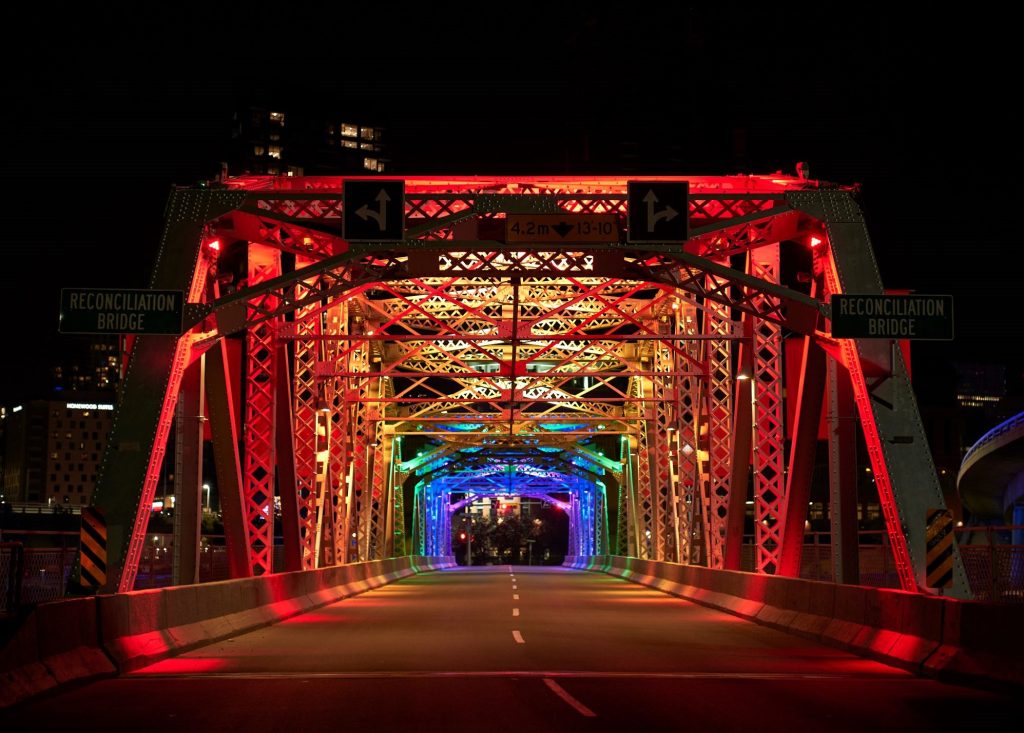
Cultural Expressions touches on folklore and traditions from The Story of Starboy (Scarface) with a dark-blue base and white lights to emulate twinkling stars, to the evocation of Bead Work through the use of primary red, blue, yellow and green lights in four static patterns that shift every 15 minutes. Other scenes expand to tell the Creation Legend of Napi The Trickster, which is visually represented with a slow shift through an entire rainbow of colors, and a Sun Dance with deep yellow and pink accents. The Bow River beneath the bridge is honored with a mixture of dark blue, light blue and sea green illumination patterns.
Six Days of Honor (or weeks) are represented in various shades of solemn hues such as uninterrupted red or orange, among others. These important dates include Missing and Murdered Indigenous Women and Girls National Day of Awareness (May 5); National Aboriginal Awareness Week and National Indigenous Peoples Day (mid-June); Day of Treaty 7 Signing (September 22); National Day for Truth and Reconciliation (September); Missing and Murdered Indigenous Women and Girls National Day of Action (October 4); and Metis Week and Louis Reil Day (mid-November).
Finally, illuminated colorways to celebrate the diversity of the city include scenes for LGBTQ Pride, Chinese New Year, the Chinook Blast Winter Festival and other joyous local events. Those interested can learn more about the full spectrum of patterns, along with which scene is currently on display, by visiting the CMLC website at Finally, illuminated colorways to celebrate the diversity of the city include scenes for LGBTQ Pride, Chinese New Year, the Chinook Blast Winter Festival and other joyous local events. Those interested can learn more about the full spectrum of patterns, along with which scene is currently on display, by visiting the CMLC website at www.evexperience.com.
COVID-19 Complications
As with any design project, updating Reconciliation Bridge had its challenges. The $500,000 CAD (~$367,150 USD) project faced an aggressive timeline of only a few months from the start of schematic design to tender issuance, and the work took place over the course of the pandemic—leaving the team to navigate logistical supply chain hindrances as well as in-person workplace hurdles.
At A Glance
• The project earned a 2023 Illumination Award of Merit.
• It was completed in February 2022.
• The illumination relies on an ETC Mosaic DMX control system with two universes of control.
THE DESIGNERS
- Geoff Bouckley, LC, Member IES, IALD, is studio lead of lightSPACE at SMP Engineering.
- Anton deGroot was formerly a lighting designer with lightSPACE at SMP Engineering and is currently an independent performing art set, light and sound designer as well as an instructor at the University of Calgary.
Historical Context as Told by a Settler
By Anton deGroot
The Reconciliation Bridge is of particular importance to our city. In the language of the Blackfoot Peoples, the original caretakers of this land, so-called Calgary is known as Moh-kíns-tsis: the name refers to the confluence of the Bow and Elbow Rivers, which our bridge sits one kilometer west from on the Bow River itself. This land remains sacred to the Blackfoot Confederacy, including peoples of the Kainai, Siksika, Piikani, Stoney Nakoda and Tsuut’ina Nations. The people who live here today, Indigenous and settler alike, remain people of Treaty 7, an agreement that dates back to the 1870s that remains in effect today. It is the responsibility of the people here—especially those of settler heritage like myself—to engage in active reconciliation with our Indigenous neighbors to make up for the crimes of the past.
I provide this context because for decades, this bridge bore the name of a settler politician [name redacted by the editors, as per the wishes of the designer, to direct attention away from the politician] who, aside from being a part of the Canadian Confederation process in the 1870s, was also one of the architects of the Canadian Indian Residential Schools—a system that did shocking and deeply traumatic harm to the Indigenous Peoples of Canada, harm which is still being unearthed and reckoned with today. As a small (but hopefully meaningful) gesture, the City of Calgary voted to rename it the Reconciliation Bridge in its nominal spirit with which we hope to continue and make amends for the past.

